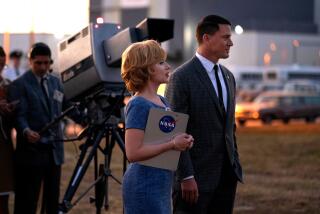Book Review : Astronaut’s Space Report Fizzles Out
- Share via
Liftoff: The Story of America’s Adventure in Space by Michael Collins (Grove Press: $25; 288 pages
I admit it. I’m a space cadet. I have been one ever since that day in October, 1957, when the Soviets launched Sputnik and our seventh-grade class discussed nothing else for what seemed like weeks.
In high school, I sweated out the launches of Alan Shepard, Gus Grissom, John Glenn and the rest. Throughout the ‘60s I sat glued to the TV and followed closely as the Mercury program turned into Gemini and then Apollo, which put men on the moon. In the ‘80s, I got to cover the space shuttle, went to launches, met the astronauts and never lost my excitement or enthusiasm for the space program.
I say all that to put my biases on the table. Understandably, I like to read about the space program, and I never get tired of it. I have kept up with the books by astronauts, ex-astronauts, would-be astronauts and others.
Among the astronauts who have written about the space program and their role in it is Michael Collins, who was a member of the crew of the first lunar landing in 1969 (though he stayed in the mother ship in lunar orbit and did not land on the surface of the moon). “Carrying the Fire” (Farrar, Straus & Giroux: 1974) was his well-told story of that flight.
Now Collins is back with “Liftoff: The Story of America’s Adventure in Space,” which traces the entire American manned space program from Shepard’s flight in 1961 to the Challenger accident in 1986. Even for a space cadet like me, this book is disappointing.
Collins’ book is a nostalgic reprise of a quarter of a century of space exploration. He adds some tidbits here and there, but not enough.
Flying United
It’s interesting to learn that double amputees were considered as the first astronauts because they would require less room in the tiny Mercury capsules. It’s also interesting to learn that Collins fantasizes about having sex in orbit: “And lovemaking!” he writes. “I don’t think any astronauts have yet been privileged to sample the ultimate use of weightlessness, but having no gravity to crush bodies together offers exquisite possibilities. A tiny pull here, a gentle touch there. A space Kamasutra remains for some lucky couple to write.”
There aren’t enough new tidbits to make the book a must-read.
Maybe the problem is that after a while, every story becomes old hat. The story of the American space program has been very well told before, both in the large and in the small. Tom Wolfe, Henry S. F. Cooper, Walter Macdougall, these are the authors to turn to if you want to know about America’s first steps into space. To be sure, Collins gives us the astronauts’ perspective. But he doesn’t come close to making us feel it the way Wolfe did in “The Right Stuff” (Farrar Straus & Giroux: 1979), a book that not only illuminated the space program but gave the language a phrase that won’t go away.
Collins’ book is serviceable and adequate, a good balance between the technical details that space junkies love and the soaring paeans to exploration that help keep the program going. It is generally well-written, though studded with linguistic clinkers here and there. After describing President John F. Kennedy’s decision to commit the nation to a lunar landing in the 1960s, Collins writes:
“We were going for the home run, all the way to the moon, to walk on its surface, and to do it all before the end of 1969! Kennedy had decided that it was in the national interest, the Congress agreed, and that was it. Kennedy had a lot of guts.”
The book contains excellent drawings by James Dean, former art director of NASA and curator of the National Air and Space Museum. They explain and add to what Collins writes about. But the pictures can’t carry the book.
More to Read
Sign up for our Book Club newsletter
Get the latest news, events and more from the Los Angeles Times Book Club, and help us get L.A. reading and talking.
You may occasionally receive promotional content from the Los Angeles Times.






